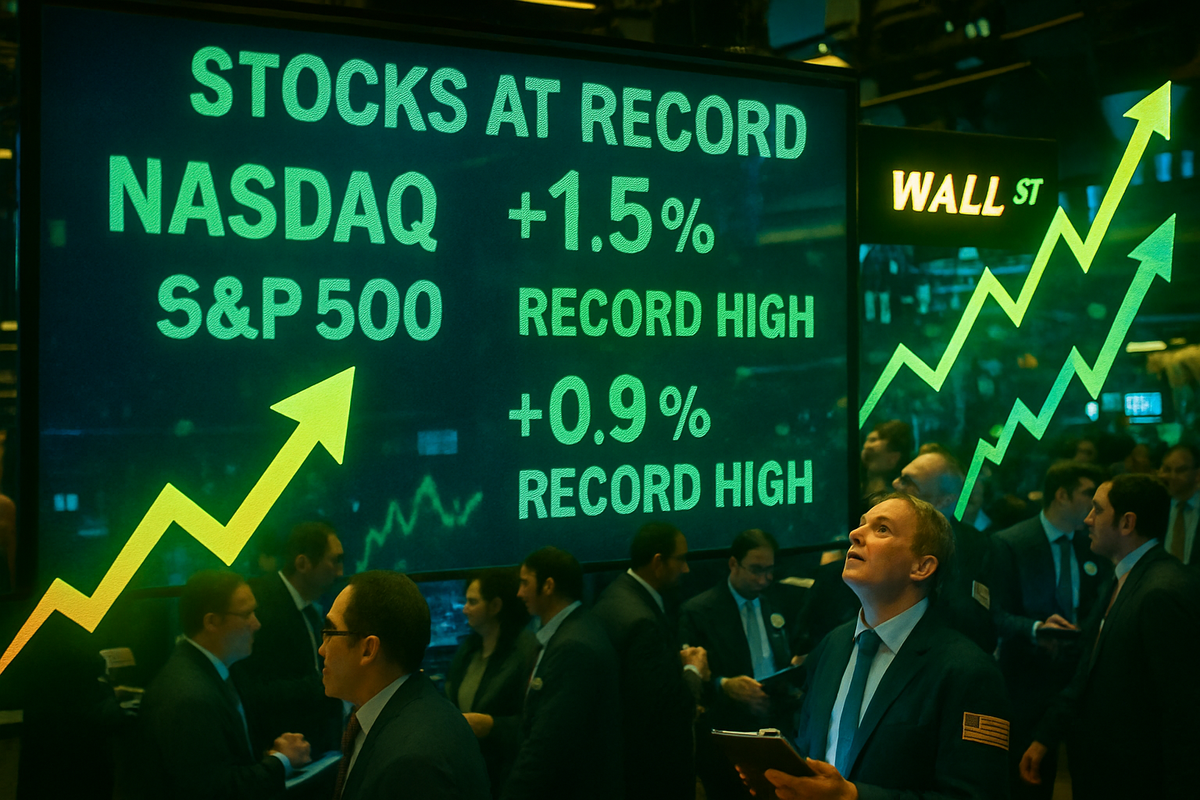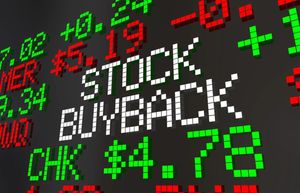
The U.S. stock market is experiencing a significant surge, with the Nasdaq Composite reaching an unprecedented new record high and the S&P 500 poised just shy of its own all-time peak. This robust performance signals a strong rebound in investor confidence, following what was recently described as the market's worst week in several months. The broad-based gains across all three major indices—the Nasdaq, S&P 500, and Dow Jones Industrial Average—underscore an overwhelmingly optimistic sentiment driving current market dynamics.
This week's impressive rally suggests a "buy on the dip" mentality has taken hold, as concerns over tariffs and the broader economic outlook appear to have subsided. The sustained upward momentum reflects a renewed appetite for risk among investors, buoyed by a confluence of positive factors that are reshaping expectations for the remainder of the year.
A Resurgent Market: What Happened and Why It Matters
The past week has been nothing short of remarkable for the U.S. equity markets, culminating in significant milestones for key indices. The Nasdaq Composite (NASDAQ: COMP) closed at a new all-time high of 21,450.02, marking its second consecutive day of record closing highs and setting a new intraday record peak of 21,464.53. Simultaneously, the S&P 500 (NYSEARCA: SPY) climbed to 6,389.45, finishing less than a point away from its first closing high since July 28, and inching closer to its previous all-time high of 6427.02 set in July 2025. Not to be outdone, the Dow Jones Industrial Average (NYSEARCA: DIA) also posted gains, reaching 44,175.61, now less than 2% away from its last new high recorded in December 2024.
This powerful resurgence follows a period of volatility, with the market demonstrating a strong "buy on the dip" mentality. The catalysts behind this week's impressive rally are multifaceted. A primary driver has been the better-than-expected corporate earnings reports, with over 80% of S&P 500 firms surpassing expectations this quarter. This strong earnings season has led analysts to revise higher earnings growth forecasts, now projected at approximately 10% for S&P 500 companies. This robust corporate performance provides a fundamental underpinning for the market's current ascent, validating investor confidence in the profitability and resilience of American businesses.
Adding to the optimistic outlook is the growing anticipation of potential interest rate cuts by the Federal Reserve. Money markets are currently assigning a 95% chance of a Fed reduction in September, a prospect that has significantly stabilized investor sentiment. Lower interest rates typically reduce borrowing costs for companies, stimulate economic activity, and make equities more attractive relative to fixed-income investments. This dovish shift in monetary policy expectations is a powerful tailwind for the stock market, encouraging further investment and risk-taking.
The timeline leading up to this moment saw a period of investor caution last week, which was described as the worst in several months for the major indices. However, the swift turnaround this week highlights the market's inherent ability to rebound quickly on positive news. Key players involved in this market movement include institutional investors, hedge funds, and retail investors, all contributing to the increased trading volumes and upward price momentum. Initial market reactions have been overwhelmingly positive, with analysts and financial commentators pointing to a renewed sense of optimism and a potential continuation of the bull market.
Tech Titans and Cyclical Stocks Lead the Charge
The current market rally, spearheaded by the Nasdaq's record-breaking performance, naturally positions technology and growth-oriented companies as significant winners. Companies like Apple Inc. (NASDAQ: AAPL), Microsoft Corp. (NASDAQ: MSFT), and NVIDIA Corp. (NASDAQ: NVDA), often bellwethers of the tech sector, are likely to see continued investor interest. Their strong earnings reports and future growth prospects, particularly in areas like artificial intelligence and cloud computing, make them attractive in a low-interest-rate environment. As the Nasdaq hits new highs, these tech giants benefit from increased valuations and investor confidence, potentially leading to further capital appreciation.
Beyond technology, the broad gains across the S&P 500 and Dow Jones suggest that cyclical sectors are also benefiting. Industrials, financials, and consumer discretionary companies, which tend to perform well during periods of economic expansion and stable sentiment, are likely to see positive momentum. For instance, large banks like JPMorgan Chase & Co. (NYSE: JPM) could benefit from a more stable economic outlook and potential increases in lending activity, even if interest rate cuts slightly compress net interest margins. Similarly, consumer discretionary companies such as Amazon.com Inc. (NASDAQ: AMZN) or Tesla Inc. (NASDAQ: TSLA) could see increased consumer spending, driven by improved economic confidence.
Conversely, companies that thrive in higher interest rate environments or those with less robust growth prospects might find themselves relatively lagging. While the overall market is up, defensive sectors like utilities or consumer staples, which are often sought after for their stability and dividends during uncertain times, might see less dramatic gains compared to their growth-oriented counterparts. Companies with high debt loads could also see their borrowing costs decrease with potential rate cuts, but their stock performance might still be overshadowed by more dynamic growth stories. However, in a broadly rising tide, outright "losers" are less apparent, with most companies experiencing some degree of positive movement.
The "buy on the dip" mentality observed this week suggests that investors are quick to capitalize on any market pullbacks, indicating a strong underlying demand for equities. This bodes well for companies across various sectors, as long as the positive economic data and earnings trends continue. The focus remains on companies that can demonstrate consistent growth and profitability, regardless of their sector, as these are the ones most likely to attract sustained investor capital in the current optimistic climate.
Broader Implications and Industry-Wide Ripple Effects
The current market surge, marked by the Nasdaq's record high and the S&P 500's near-record performance, fits squarely into a broader trend of resilient economic activity and a potentially more accommodative monetary policy. This event signifies a strong vote of confidence in the U.S. economy's ability to navigate various headwinds, including geopolitical tensions and inflationary pressures. It suggests that the market believes the Federal Reserve can achieve a "soft landing," bringing inflation under control without triggering a severe recession. This optimistic outlook could encourage businesses to increase investment and hiring, further bolstering economic growth.
The ripple effects of this market rally are significant. For competitors, particularly those in the technology sector, the elevated valuations of market leaders could intensify the pressure to innovate and demonstrate strong growth. Smaller, emerging companies might find it easier to raise capital as investor appetite for risk increases, potentially fueling further innovation and competition. Partners across supply chains could also benefit from increased demand and investment from their larger, more confident counterparts. For instance, semiconductor manufacturers like Taiwan Semiconductor Manufacturing Company (NYSE: TSM) could see sustained demand from tech giants expanding their operations.
From a regulatory and policy perspective, a booming stock market might reduce the immediate pressure on policymakers to implement aggressive stimulus measures. However, it could also lead to increased scrutiny regarding market concentration and potential antitrust concerns, especially if the gains are heavily skewed towards a few dominant players. Historically, periods of sustained market rallies have often been followed by increased regulatory attention to ensure market fairness and prevent excessive speculation. Comparisons can be drawn to the post-dot-com bubble era or the pre-2008 financial crisis period, where rapid market expansion eventually led to calls for tighter regulations. However, the current rally appears to be more fundamentally driven by earnings and interest rate expectations rather than speculative fervor.
The overall industry impact is one of renewed optimism and potential expansion. Companies across various sectors may feel more confident in pursuing mergers and acquisitions, investing in research and development, and expanding their global footprints. This positive feedback loop, where market confidence fuels corporate investment and vice versa, could lead to a sustained period of economic growth. The key will be for this growth to be broad-based and sustainable, avoiding the pitfalls of over-speculation or unchecked exuberance.
What Comes Next: Navigating the Path Forward
Looking ahead, the immediate future for the U.S. stock market appears promising, with the potential for continued upward momentum. In the short term, investors will be closely watching upcoming economic data releases, particularly inflation reports and employment figures, to gauge the Federal Reserve's next moves. Any signs of persistent inflation could temper expectations for interest rate cuts, potentially leading to market volatility. Conversely, continued moderation in inflation coupled with stable employment could solidify the case for a September rate reduction, providing further impetus for the market. Corporate earnings reports for the next quarter will also be crucial, as sustained profitability is essential to justify current valuations.
In the long term, the market's trajectory will depend on several key factors. The pace of technological innovation, particularly in artificial intelligence and other transformative technologies, will continue to drive growth in the tech sector. Geopolitical stability and the resolution of ongoing trade disputes will also play a significant role in maintaining investor confidence. Companies may need to strategically pivot or adapt to evolving consumer preferences and global supply chain dynamics. For instance, businesses heavily reliant on international trade might need to diversify their supply chains to mitigate future disruptions.
Market opportunities may emerge in sectors that are currently undervalued but possess strong long-term growth potential, or in companies that are poised to benefit from structural shifts in the economy. Challenges could include unexpected economic downturns, a resurgence of inflation, or unforeseen geopolitical events. Potential scenarios range from a continued "goldilocks" environment of moderate growth and contained inflation, leading to a sustained bull market, to periods of increased volatility if economic data or policy decisions deviate from current expectations. Investors should remain agile and prepared to adjust their portfolios based on evolving market conditions.
The current optimistic sentiment, while strong, is not without its risks. A significant shift in the Federal Reserve's stance or a sudden deterioration in corporate earnings could trigger a market correction. Therefore, while the outlook is positive, a cautious and well-researched approach to investing remains paramount.
Conclusion: A Resilient Market Poised for Growth
The recent surge in the U.S. stock market, highlighted by the Nasdaq Composite's new record high and the S&P 500's proximity to its own, marks a significant turning point after a period of uncertainty. The key takeaways from this event are the market's remarkable resilience, its strong "buy on the dip" mentality, and the powerful combination of robust corporate earnings and the anticipation of Federal Reserve interest rate cuts. This confluence of factors has instilled a renewed sense of optimism among investors, driving broad-based gains across all major indices.
Moving forward, the market appears to be on a solid footing, supported by fundamental economic strengths and a potentially more favorable monetary policy environment. The strong performance of technology companies, coupled with the broader participation of cyclical sectors, suggests a healthy and diversified rally. However, investors should remain vigilant, closely monitoring inflation trends, the Federal Reserve's communications, and geopolitical developments. The market's ability to sustain this momentum will depend on the continued delivery of strong corporate earnings and the realization of anticipated interest rate adjustments.
The lasting impact of this period could be a reinforcement of the U.S. equity market's reputation as a resilient and attractive destination for capital. It underscores the importance of adapting to changing economic landscapes and capitalizing on opportunities presented by technological advancements and evolving monetary policies. Investors should watch for signs of sustained economic growth, further improvements in corporate profitability, and any shifts in central bank rhetoric. While the current outlook is overwhelmingly positive, a balanced approach that considers both opportunities and potential risks will be crucial for navigating the months ahead.






